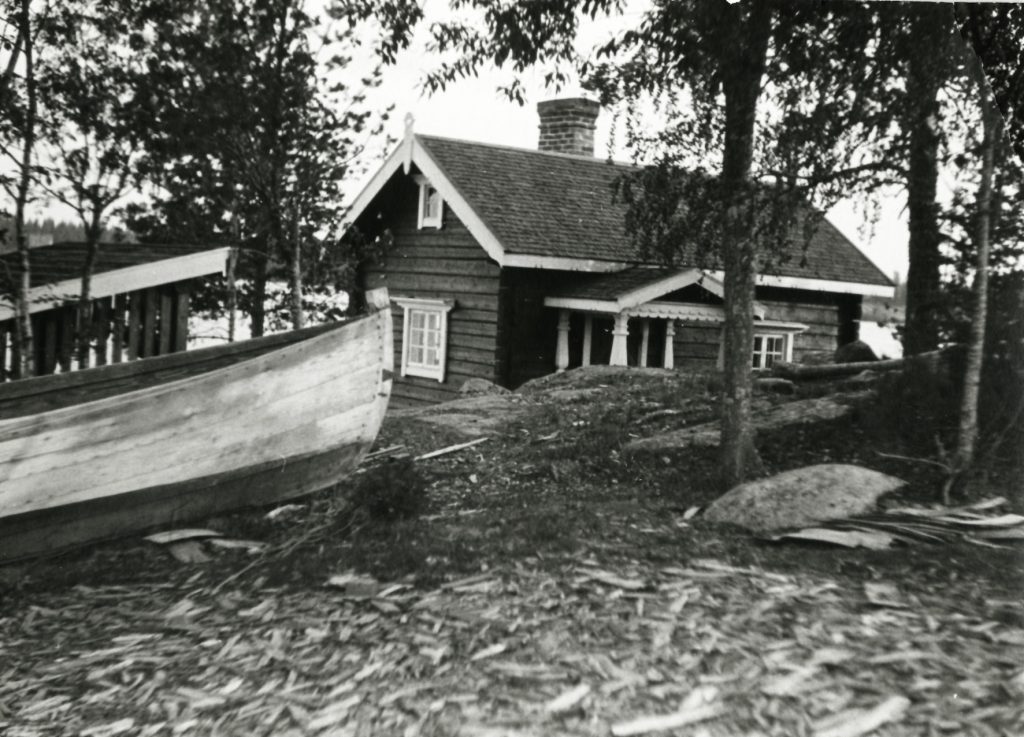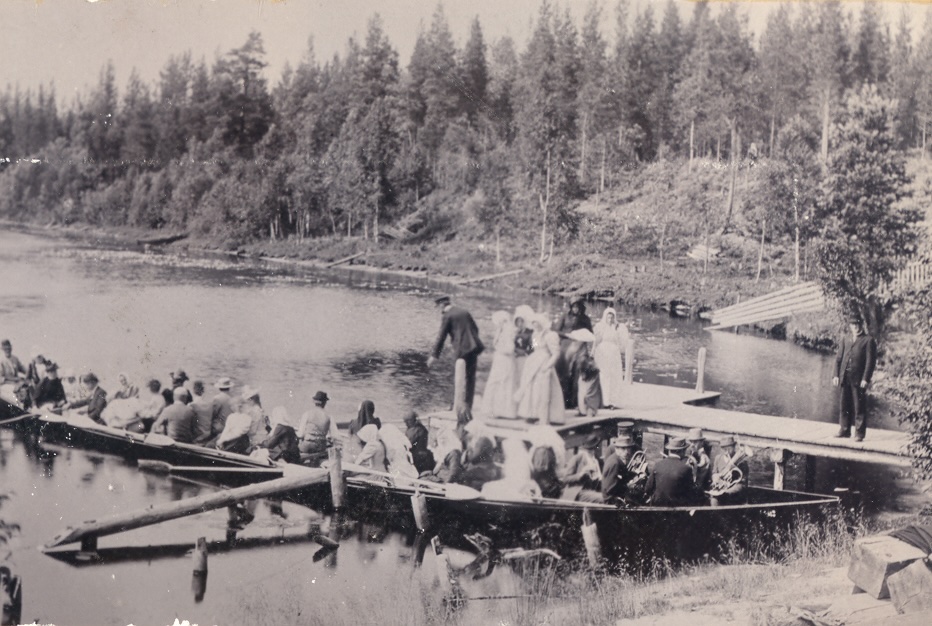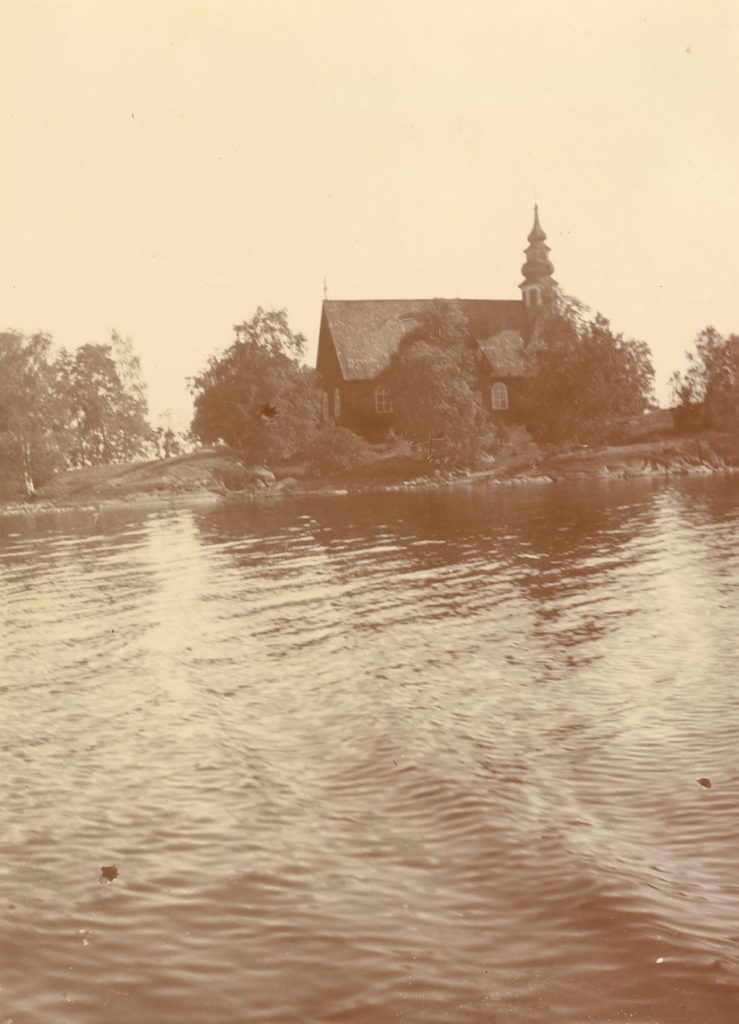Church boat on Taavetti Island
AUGUST 2024
The photograph taken of Taavetinsaari shows the sauna building and the bow of the church boat by the name Liukas (Agile). The photograph is from Dagmar Järvinen’s collection, who served as a maid at Joenniemi Manor.
The Kuorevesi Society, which started its operations in 1955, received a letter dated 23.10.1956 from MA Lasse Sevelius, administrator of the Gösta Serlachius Fine Arts Foundation:
An old church boat is preserved on the island connected to the Joenniemi Manor in Mänttä. Since a museum is currently being established in Kuorevesi, the idea has arisen that this boat would be suitable there, all the more so since it was once used for church trips to Kuorevesi. The boat has been stored under a canopy. It’s a bit broken at the stern, but very repairable. Ruth Serlachius, who owns the boat, has announced that she is willing to donate it to you.
Eeva Laaksi, President of the Kuorevesi Society, sent letters of thanks to Mrs Serlachius and Mr Sevelius. In her letter, Laaksi asked the latter for other information about the boat, such as the place of purchase, price and name. Unfortunately, Sevelius’ letter in reply is missing.
It is therefore not known when the Serlachius Family had acquired the church boat, which can be seen in photographs taken in Taavetinsaari already in the 1930s. The reason for the acquisition may be Gösta Serlachius’ interest in peasant culture. For example, he had financially assisted the people of Kuorevesi in creating their folk costume.
The Kuorevesi Society was established in 1955 to implement the museum project. However, the church boat was not placed in the museum of local history. In stead people thought it would find a more suited context in the Kuorevesi church, where its last church trips had been headed to.
Liukas had made its first church trips to Keuruu Church. The 11-oared Liukas is said to have been built in Häkki-Liukko farm in 1885. Boat builder Aatami Mäntyniemi is most often mentioned as its boatwright, but apparently there is no absolute certainty about its creator.
According to the story, when the pine tree growing on the slope was felled to be used for constructing the church boat, it slid down the hill, felling smaller trees underneath. People say that house holder of Häkki-Liukko farm, Aaro Liukko stated that one should be able to make fast-moving boat from a tree that slips like that on the solid ground. The boat became known as Liukas (Agile). It served the Liukko boat crew in Keurusselkä from the 1800s to the early 1900s.
At the turn of the century, the number of church boats decreased significantly. Then, steamboat Keuru (1885) and paddlesteamer Elias Lönnrot (1892) travelled on Lake Keurusselkä the. Liukas was purchased as a church boat for the Riihimäki boat crew in Kuorevesi, where the Kuorevesi ship operated schedule-based between Kuorevesi and Mänttä in 1914–1920. A boat shelter was built on the Viitala estate shore in the village of Suinula.
In 1911, the founder of the Seurasaari Open-Air Museum, ethnologist A. O. Heikel, wrote that he had visited the church boat Liukas, built in 1885, in Suinula. Heikel, who was on a trip to identify and list church boats, had received a tip about a boat that had been sold from Keuruu to Kuorevesi a couple of years earlier.
Heikel wrote that the boat was 13-oared (not 11-oared), but the dimensions of the boat were the same as those of the church boat at Kuorevesi Church (length: 18 m, width: 1.9 m). Heikel photographed the boat and its canopy.
According to Heikel, after its purchase, the boat was painted white and its upper edge green. The seats of the boat with oarlocks were loose boards. They were supported by wooden molding running along the inner edges of the sides. Each oar had a wooden mark of the owner or house. The longest oars were in the middle of the boat, and the shorter ones were in front and rear parts. The blades of the oars were painted red. On the way to church, a picnic chest was kept in the middle of the boat.
Church boat Liukas was moved from Joenniemi to Kuorevesi Church on 25 March 1957 and temporarily covered. The construction of a boat shelter still had to be solved. According to the curator of the Seurasaari Open-Air Museum, an open floor boat shelter built on a coffin structure was typical in the region and the only one that came into question.
To the Kuorevesi Society, Ruth Serlachius also donated a church boat shelter from Joenniemi. The new boat shelter, made partly from an old boat shelter and partly from timber donated by the Kuorevesi parish, was completed in 1958. Due to lack of funding, the completion of the boat shelter roof was delayed until the following year.
Katri Tolonen
Curator
Sources:
Heikel, A. O.: ”Kirkkoveneitä”, Suomen museo XVIII 1911. Suomen Muinaismuistoyhdistys, Helsinki, 1911
Jämsän seurakunta. Kuoreveden seurakunnan arkisto. Kirkkovaltuuston pöytäkirjat 18.3.1957, 29.4.1957.
Kuorevesi-Seuran arkisto. Pöytäkirjat, vuosikertomukset ja kirjeet vuosilta 1956–1959
Pänkäläinen, Hillevi (2019): ” Liukon Liukas – kirkkoveneen monipolvinen tarina”, Keuruun Joulu 2019.
Tolonen, Marja: Kirkkovene Liukas. Opastekyltti Kuoreveden kirkolla.




